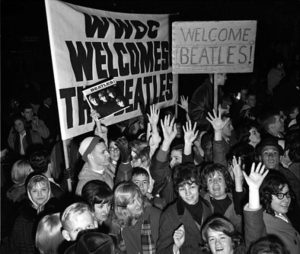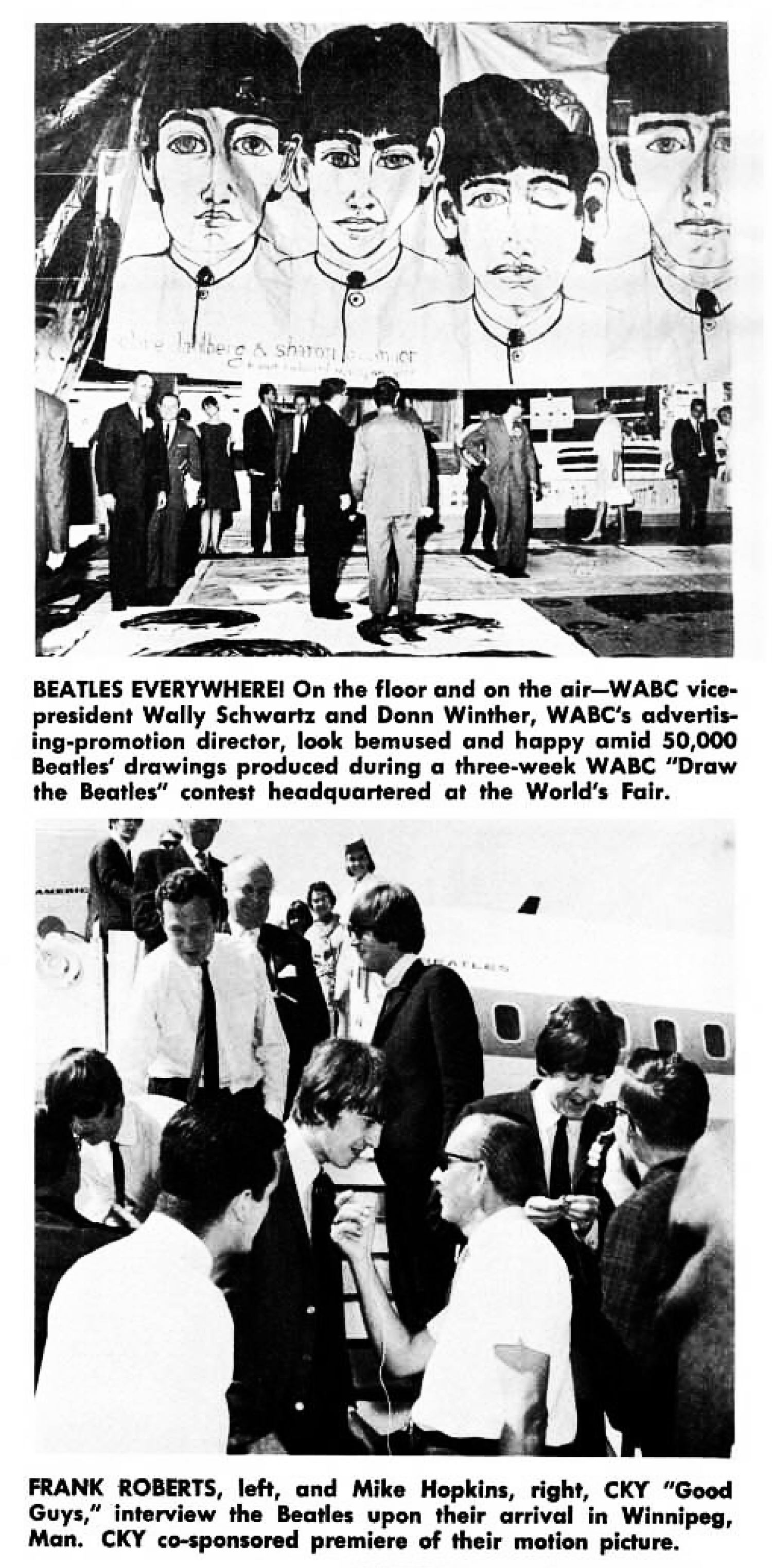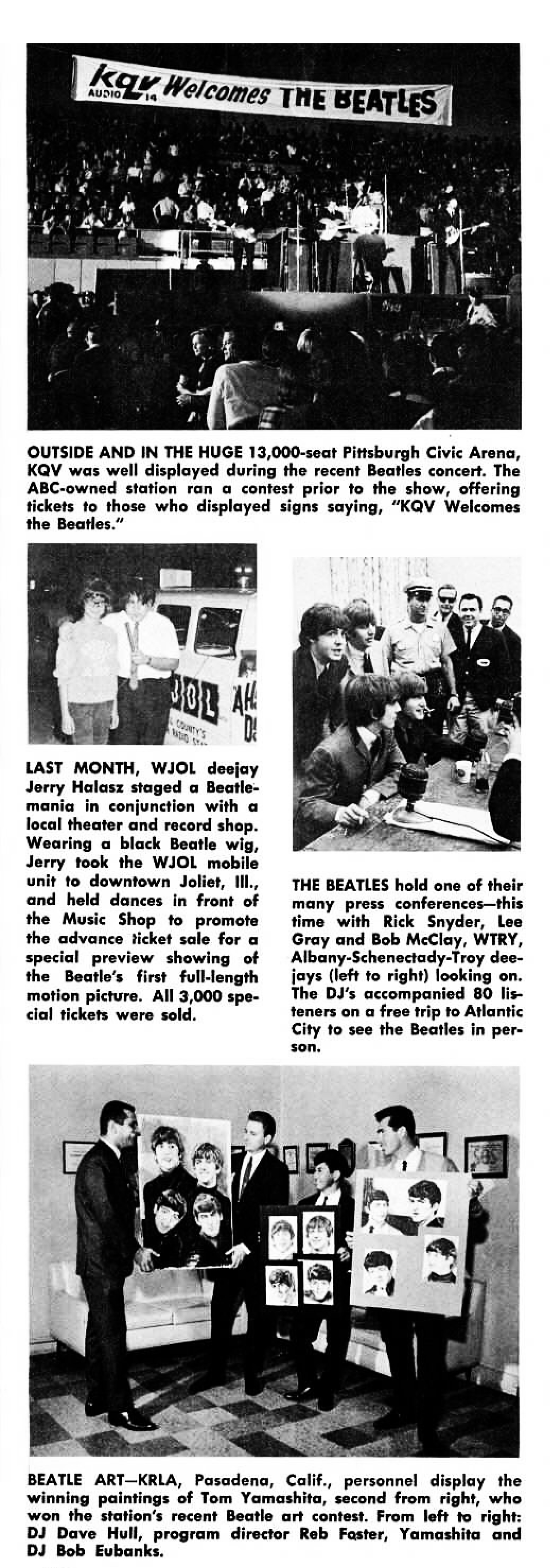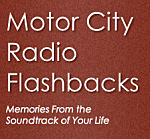Some Radio Stations Pulling Stops From Losing Adult Audiences to Current ‘Beatlemania’ Hysteria
NEW YORK – With the Beatles safely home after their record-breaking tour of the United States and Canada, broadcasters are mulling the cause and effect of “Beatlemania.”
In attempting to evaluate a phenomenon like the Beatles the inevitable question arises as to what caused the hysteria – the Beatle fans as a result of radio, or radio, under pressure of Beatle fans.

No matter who caused it, never before in the history of radio broadcasting has any group or individual from the entertainment world received such overwhelming support. Beatlemania struck radio with unprecedented impact, sending many thousands of hours of related programming into the airwaves.
The involvement by radio has gone far beyond the mere playing of Beatles records. Contests, promotions, extensive news coverage, pilgrimages to England, etc., became standard procedure.
The cities with more than one contemporary music-formatted station enjoyed (or cringed) as two or three stations battled to out-Beatle each other.
Radio programmers explain that the affair was not one of love alone, but an effort to cash in on what was mushrooming into the latest (and perhaps biggest) pop music craze ever to hit this continent.
Others argue that the mania is attributable primarily to the tremendous radio station involvement and identification with the Beatles. The “Monster” was of their own making.
Serious Drawbacks
Industry programmers caution that Beatlemania with its strong appeal to teenagers could result in driving away adults that enjoy contemporary pop
pop music. It has also been noted by many the possibility that rhythm and blues and the more conservative music stations have attracted many listeners away from pop stations as a result of the latter’s preoccupation with the English sound.
Just how much good, or harm, the Beatles have done to radio is being measured. Programming executives are carefully watching station audience composition studies and the ratings to determine if the new seven to 12-year old listeners captured by Beatle broadcasting has resulted in a loss for contemporary music stations of adults.
The Beatles of Liverpool, like the Pied Piper of Hamelin, have a mysterious musical lure for even the smallest of tots. Why?
“It’s their honesty, in part, plus the fact that they look like cuddly dolls,” says producer Jack Good of ABC -TV’s “Shindig,” on which the Beatlemania of John, Paul, George and Ringo will resound Wednesday, Oct. 7.
Another ABC-TV show bows Saturday, Oct. 10 to the demand of Beatle fans. Dick Clark will present an all-Beatle program on the “New American Bandstand-’65,” including the pick of their latest recordings, a portion of their latest motion picture, several taped interviews procured from KRLA, Pasadena, and KRLA deejay Casey Kasem’s recording of “A Letter From Elena.”
The flames were further fanned by many stations, who not content to refer to the group in the second person, dispatched their top newsmen and deejays on the recent 30 -day junket made by the boys from Liverpool.
Among the air personnel who traveled with the Beatles to tape on-the-spot personal reports and interviews for their stations back home included Larry Kane, newsman, WFUN, Miami; Art Schrieber, news director of KYW, Cleveland; Jim Stagg, KYW deejay, and Long John Wade, WDRC, Hartford, deejay. Most stuck it out for the whole tour.
Contests and Promotions
Nearly every conceivable type of contest and promotional tie-in with the British group has been tried by stations here and in Canada.
CHWO, in Canada, conducted a “Beatle Bonanza” in connection with the showing of “A Hard Day’s Night.” A special phone answering switchboard set up to handle the calls was swamped and eventually broke down. KDKA’s promotion manager, Owen Simon, and 17 other station staffers went into the streets of Pittsburgh with 40 tickets to the movie. WOWO, Fort Wayne, Ind., “Pussycats” were similarity beaten in a group singing honors. The “Pussycats,” comprised of deejays from WOWO, were edged out in a contest which drew 52,000 postcards during the three-week battle.
WIBC, Indianapolis, selected 35 questions from more than 3,500 submitted by listeners to he relayed to the Beatles in London. They recorded their answers, sent the tape to WIBC and the WIBC Beatles Press Conference became a ruddy success. The station was also designated as the “Mid-America Chapter of the Beatles National Fan Club.”
Both WQAM and WFUN iMiami, flew a planeload each of listeners to the Beatle concert in the Gator Bowl. The stations ran contests to pick the lucky entourage. WJZ -TV, Baltimore, ran a “Beatles Forever Contest” in conjunction
with the station’s “People Are Talking” program. The grand prize winner received an all-expense-paid trip for two to Pittsburgh to see the Beatles. Toronto was typical of the cities that experienced personal Beatle visits.
CHUM garnered all of its manpower to cover the event and featured broadcasts from the hotel lobby while George Harrison’s sister Louise (flown to town courtesy of CHUM) broadcast her comments from a suite overlooking the hotel entrance.
The next day – Beatles Day – every second record played by CHUM was by the Beatles. CHUM played a part during and after the concert at Maple Leaf Gardens.
One of the footnotes to Beatlemania was the WGUY, Bangor, Me., ban on Beatles records which resulted in a group of teenagers picketing the studios.
In announcing the Beatles disk ban, William Hart, general manager of WGUY, declared the station would “no longer be part of a drive to build a Beatle empire.” END
___
(Information and news source: Billboard; October 10, 1964)


![]()



